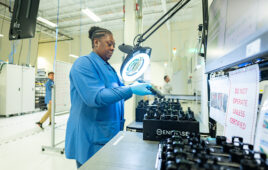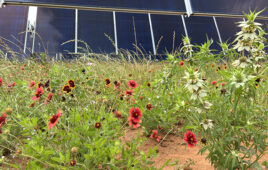The Texas electric marketplace could experience some shifts in the coming months. The state Senate passed two bills in May that are supposed to spur winter weatherization for existing fossil fuel infrastructure. But industry members are waiting to see how the new legislation will affect the renewable energy market.

Credit: Sunrun
It’s been nine months since Winter Storm Uri passed through the state and knocked out significant portions of Texas’ decentralized electrical grid, cutting off electricity to millions and causing the deaths of hundreds of people. Following the storm, legislators, including Texas Gov. Greg Abbott, falsely lambasted renewables, blaming wind and solar as the primary source of the sustained blackouts.
“This shows how the Green New Deal would be a deadly deal for the United States of America,” Abbott said in an interview on Fox News back in February, while the state was still addressing the blackouts. “Texas is blessed with multiple sources of energy, such as natural gas and oil and nuclear, as well as solar and wind. But…our wind and our solar got shut down and they were collectively more than 10% of our power grid and that thrust Texas into a situation where it was lacking power in a statewide basis.”
While certain wind and solar projects did indeed cease operations during the storm, the Electric Reliability Council of Texas (ERCOT) — the organization regulating Texas’ electric grid — reported that every energy source in the state was down in some capacity. Natural gas is the state’s primary energy source, and when wells and pipelines froze, swaths of the state experienced outages.
As a coal, natural gas and oil-rich state, Texas seceded from the federal electric grid in 1995, deregulating the state’s entire grid except for its northernmost territory, which is outside of ERCOT’s jurisdiction. It maintains several connections to Mexico and the eastern U.S. electrical grids, but remains otherwise independent.
More than half of the natural gas pumps supplying power on the ERCOT grid weren’t functioning during the winter storm; and additional power line congestion in certain territories kept power from getting to where it was needed.
“It’s interesting at this juncture as some people are wanting to re-evaluate this whole 20-year experiment in deregulation,” said Matt Welch, state director of Conservative Texans for Energy Innovation (CTEI). “That’s where we find ourselves today with the PUC and ERCOT. It’s time to take a hard look at: Did we do it right? Where can we fix it? Where can we improve? Where can we move the ball forward?”
Following the Texas blackouts, Abbott demanded additional measures for reliability and weatherization for the state’s electrical grid. Before going on recess in May, the Senate passed two bills that included language potentially detrimental to solar development in the state: Senate Bills 2 and 3.
SB 2 initially intended to reform ERCOT by changing who could serve on the organization’s board. To be eligible for a seat, a power generator had to control more than 5% of installed capacity on the ERCOT grid. Even though Texas is the country’s second-largest solar state, solar accounted for less than 3% of its electrical output as of 2020. No individual solar developer could meet that 5% qualification, leaving solar off the bench.

Credit: Ørsted
However, the bill was revised before passage and the board will now be represented by individual members selected by a governor-appointed committee.
Industry groups considered SB 3 harsher toward renewables for its proposed fees on ancillary grid services — the functions responsible for keeping a consistent power supply by maintaining grid voltage and frequency.
There can be fluctuations in power supply when renewables and other intermittent generators don’t perform on the grid as predicted, and legislators wanted to attach the costs incurred by that strictly to renewable project owners. Utility customers traditionally covered those costs.
State renewable groups lobbied against the inclusion of that language and were successful in revising it to a broader interpretation, since renewables are not the sole intermittent generators on the ERCOT grid.
Now, they’re waiting to see how the Public Utility Commission of Texas (PUCT) will interpret that language. After SB 2 and 3 passed in May, the legislature sent them to the PUCT for implementation. The commission will now determine the cost and recipient of the fees generated by ancillary services, as well as track other electric market alterations, including weatherization of existing infrastructure.
Nothing is final at this point, and the PUCT is hosting work sessions with energy industry members several times a month to shape the state’s electrical grid. On Oct. 20, solar industry groups including SEIA, CTEI and Sunrun sent recommendations to the PUCT petitioning for ratepayer protections, greater competition and “promotion of high-quality grid infrastructure.”
Instead of a liability, CTEI views distributed generation sources like solar as a way to add resiliency to the grid. CTEI director Welch suggested investing in local solar + storage installations or other microgrids to act as “mini-ERCOTs” to take weight off of energy centers like West Texas that are responsible for distributing power to populated areas.
“Distributed resources are a way for that to begin — the process of solving those challenges or building our infrastructure for the next century,” he said. “We need to take a hard look at that, and I think ERCOT is doing that. I just don’t know when they’re going to make it a priority.”
The PUCT will deliver a final plan in December, and clean energy organizations will still require some interpretation upon publication.
Regardless, the next U.S. winter approaches.





Repeating (giving air) to Abbotts FUD is not only a disservice it gives that nonsense air time.
Texas IS a disaster but Hope abounds, as a result of that Ice Storm and a lot of idiocy on the part of Polical Mouthpieces there is a huge ramp-up on solar & Battery Installations (without grid tie in) as people realize that Independence fgrom the Grid is actual Freedom & Independence.
“As a coal, natural gas and oil-rich state, Texas seceded from the federal electric grid in 1995, deregulating the state’s entire grid except for its northernmost territory, which is outside of ERCOT’s jurisdiction. It maintains several connections to Mexico and the eastern U.S. electrical grids, but remains otherwise independent.”
El Paso figured out in the big freeze of 2011 something would have to be done. So, El Paso connected to a transmission line from New Mexico and did not suffer like the aggregate co-ops under ERCOT did this time around. Apparently “opting out” of the “federal electric grid” in 1995 did not entail taking responsibility for their own “distributed grid” and the adoption of “best practices” that would have demanded hardening the grid and ancillaries for both extreme low temperatures as well as extreme high temperatures.
“There can be fluctuations in power supply when renewables and other intermittent generators don’t perform on the grid as predicted, and legislators wanted to attach the costs incurred by that strictly to renewable project owners.”
This is why many new solar PV farms and wind farm projects have energy storage units as part of the project built into the overall system. It has taken hold since about 2016, and has been found numerous times to be cheaper than trying to run coal fired plants for generation and capacity services to the grid. The ability of electronically switched generation from a large BESS attached to the solar PV or wind farm or even to the larger grid as a energy storage and time shifting asset allows FCAS grid services available in milliseconds to seconds instead of several minutes to perhaps hours to ramp up to meet grid load demands. The original “big battery” installed across the Neoen Wind farm in Australia was (only) 100MW/129MWh in design and the amount of grid services provided by this one asset, paid off the system in about 2.5 years of use. Now we have projects in places like California where the Moss Landing ESS is built out to 300MW/1,200MWh. It has already been proposed this can be expanded to 400MW/1,600MWh, multi gigawatt projects are starting to become the new normal not the exception. The impending Elkhorn project should make the Moss Landing area a total of 1,500MW/6,000MWh of BESS when finished just before the Diablo Nuclear plant is decommissioned in 2025. Being proactive instead of reactive like Texas and ERCOT have found out the hard way, makes for unhappy customers. IF one does this long enough, there will be few customers to disappoint.